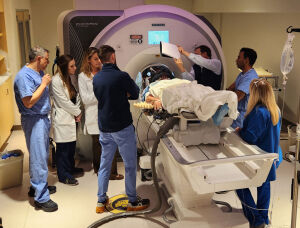by
John R. Fischer, Senior Reporter | January 15, 2024

The WVU RNI team performs focused ultrasound on an Alzheimer's patient.
According to the results of a first-in-human study, using focused ultrasound to disrupt the blood-brain barrier may allow for more successful and faster deliveries of Alzheimer’s drugs, potentially reducing the dosage needed for such therapies and the time necessary for them to effectively treat patients.
Researchers at West Virginia University Rockefeller Neuroscience Institute gave two men and one woman with mild Alzheimer’s six standard monthly infusions of aducanumab, an anti-amyloid-beta (Aβ) monoclonal antibody treatment for breaking down amyloid-beta plaques, a core component in the disease’s progression. More than 98% of drugs like this cannot readily cross the blood-brain barrier, a protective layer between blood vessels and the brain, forcing Alzheimer’s patients to undergo infusions every few weeks for at least 18 months and at higher doses,
according to the Associated Press.
But using Insightec’s Exablate Neuro platform, an MR-guided FUS helmetlike solution with more than 1,000 ultrasound transducers, the RNI clinicians were able to safely and temporarily open the BBB long enough to allow the aducanumab to slip through the barrier into areas with high amounts of amyloid plaques.



Ad Statistics
Times Displayed: 46590
Times Visited: 1409 MIT labs, experts in Multi-Vendor component level repair of: MRI Coils, RF amplifiers, Gradient Amplifiers Contrast Media Injectors. System repairs, sub-assembly repairs, component level repairs, refurbish/calibrate. info@mitlabsusa.com/+1 (305) 470-8013
“After six months of antibody treatment, we observed an average of 32% more reduction in amyloid-beta plaques (53% centiloid) in brain areas with blood-brain barrier opening compared to areas with no such opening,” said Dr. Ali Rezai, lead author of the study and executive chair of the RNI, in a statement.
Guided by MR imaging, the technology, which has been used to
treat Parkinson’s and
essential tremor, applies sound waves to precise areas of the brain. The sound waves vibrate microscopic bubbles injected into the bloodstream, causing them to create small gaps in the BBB big enough for medications to cross through. Previous studies showed that the technology could create tiny holes that seal up within 48 hours, but this is the first to administer an Alzheimer’s drug during this time window.
After six months, the researchers used PET scans to assess the amount of amyloid in these areas. While too small to make any definitive assessments, they say the study could lead to larger, more extensive ones that could indicate if the technique makes a significant difference. Rezai and his colleagues are already planning another involving a better-proven drug, Leqembi.
Dr. Eliezer Masliah, of the National Institute on Aging, who was not involved in the study, told the AP that it is also necessary to see if faster drug delivery might increase the risk of bleeding and swelling in the brain, a serious side effect of these drugs.
“It’s very exciting, compelling data. It opens the door for more extensive, larger studies, definitely,” he said.
The findings were published in the
New England Journal of Medicine.

